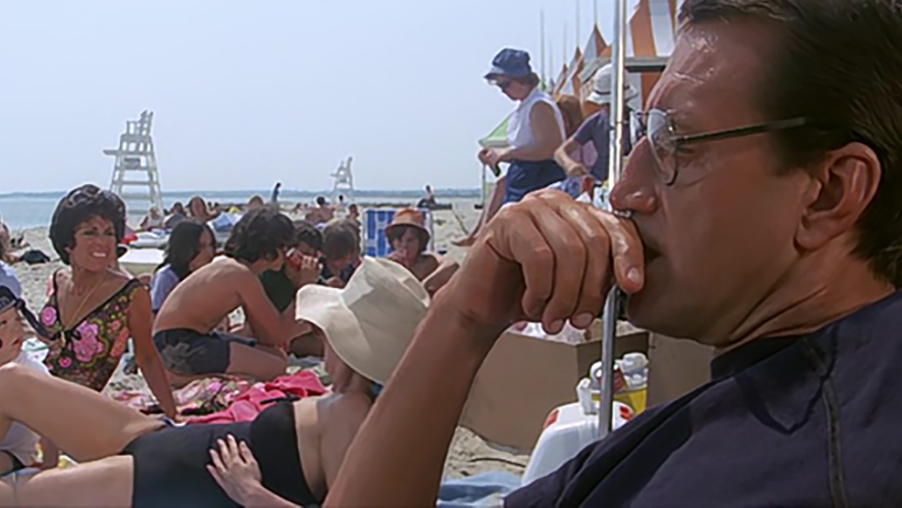Who would have that that when author Peter Benchley released his 1974 novel “Jaws” that it would end up being turned into one of the most seminal sea-monster stories ever filmed, making not only a success of Benchley, but in essence, the career of Steven Spielberg, who would go on to become one of the most well-known and respected directors in Hollywood? A litany of shark movies have since tried to imitate the success of this picture, with efforts ranging from moderately successful (“Deep Blue Sea”) to abysmal (“2-Headed Shark Attack“), but none have been able to duplicate the impact of the 1975 adventure/horror film “Jaws,” a film, that with budget of only $8M, ended up winning three Oscars and made legions of beachgoers terrified to go in the water.
The film introduces us to Chief Brody (Roy Scheider), a police officer from New York City who has relocated to Amity Island (“Jaws” was filmed mostly in or around Martha’s Vineyard, an island off the coast of Cape Cod) with his wife and two sons, hoping to start over. Jaded from the high crime of the Big Apple, Brody is content to attend to the island’s low-level police urgencies such as broken picket fences and 4th of July parades. That is, until a young woman’s remains are found off the coast, with all signs pointing not to foul play, but a shark.
“Jaws” might be more than a cautionary tale against swimming in the ocean, but a warning on ignoring small problems until they become too large and difficult to manage. Mayor Vaughn (Murray Hamilton, who, stricken with cancer, unfortunately passed away shortly after his role in “Jaws 2”), along with his staff, quickly discourage Brody from pursuing shark attack as a cause of death, seeing the financial damage such a tragedy would bring to Amity, a community whose survival is largely contingent upon tourist dollars. However, a subsequent attack, witnessed by a large number of islanders (Brody and Vaughn’s own children included), sends the Mayor into action. Brody brings in a oceanic expert (Richard Dreyfuss), and the town hires a rouge fisherman (Robert Shaw) to come in and kill the shark.
With “Jaws,” Director Steven Spielberg managed to craft a perfect blend of adventure and horror, a credit to a detailed script, believable and engrossing characters, and, or course, the fear of the unknown which the film’s antagonist instills in both its onscreen victims and the film’s audiences. The character development in the film is top of the line, presenting a motley crew of heroes we’re not used to seeing. For example, we have Quint (Shaw), a blue collar, profane, and utter loner who’s not used to working with others, set against Hooper (Dreyfuss), a oceanographer from a well-to-do family who owns his own boat and host of expensive equipment. Throwing in Brody as the Chief of Police further blurs these lines, as a family man not used to being out of his element, not to mention the fact that he’s absolutely terrified to be on the water. As tensions rise, each man must confront his personal demons, often with mixed results.

“Jaws” is filled with superb acting all around, with even the minor characters bringing more to the table than we are used to seeing. For instance, Lorraine Gary, who plays Brody’s wife, as well as Jeffery Kramer, who plays Brody’s deputy Hendricks, create engaging characters without much screen time. The film is really split into two parts: the first, as the town is victimized by the shark but is not yet called to action, and the second aboard Quint’s ship Orca, as the trio of islanders hunt down a shark that continues to evade them at every turn.
The three leads bring such talent to the table it’s almost impossible to single out a best actor among them. As Brody, Scheider is believable as an unwitting companion to these men, appearing timid, uneasy, and completely out of his element. A scene where the other two men trade sea mishaps and war stories while Brody looks on with nothing to add shows a camaraderie between seasoned sailors that Brody simply doesn’t have. As Hooper, Dreyfuss likewise brings unique talent to his character. A scientific expert, Hooper shows competence in tracking the shark, but often comes at odds with Quint, who accuses him of being enveloped in the safety of money and not having any real guts or instinct for the open sea.
Spielberg was able to create suspense in unlikely ways, predominately by never allowing the audience to see the full scale of the film’s chief menace, a 25-foot Great White shark. Quint employs a harpoon gun with floating barrels to keep the shark afloat; these barrels instead become indicative of the shark’s reappearances throughout the rest of the film. Menace is also created through the film’s most ominous scene, a conversation the three have late at night, below decks, as Quint recounts the terrifying hours he spent in the ocean after the sinking of the U.S.S. Indianapolis as hundreds of his crew mates are devoured by sharks. “I’ll never wear a life jacket again,” he states. Shaw is in complete command of his character. It’s not through this tragic tale, but from the blank look in his eye, that we believe him.
“Jaws” is another example of the kind of film producers used to make, a monster film that has as its protagonist not aliens, demons, or abominations, but a Great White shark, a real-life creature whose sheer size alone makes it a formidable reason to avoid swimming in unknown waters. The film is more than a shark hunt and a horror story, but also of everymen conquering their own personal demons. The film utilizes more than the technological tricks of the day, but superb storytelling and aligning the audience with the common man to make its lasting impressions. What Benchley and Spielberg understood was that having these events happen to people the audience can relate to is much scarier than the same events happening to a group of people we care nothing about, such as a group hotshot scientists as seen in Renny Harlin’s “Deep Blue Sea.”
Despite the precise acting and top of the line set pieces, make no mistake about it…”Jaws” is a horror movie. The fear that it managed to instill in beachgoers is a fear that still holds true after all this time since its release. There’s something instinctive, something elemental about the word ‘shark’ that “Jaws’” Mayor Vaughn understood all too well. “You yell barracuda, and everyone says, ‘huh,’ ‘what?’ You yell ‘shark’—and we’ve got a panic on our hands on the 4th of July.”



4 Comments
Pingback: » The Village (PG-13)
Pingback: » Cloverfield (PG-13)
Pingback: » The Gate (PG-13)
Pingback: » Cabin Fever (R)